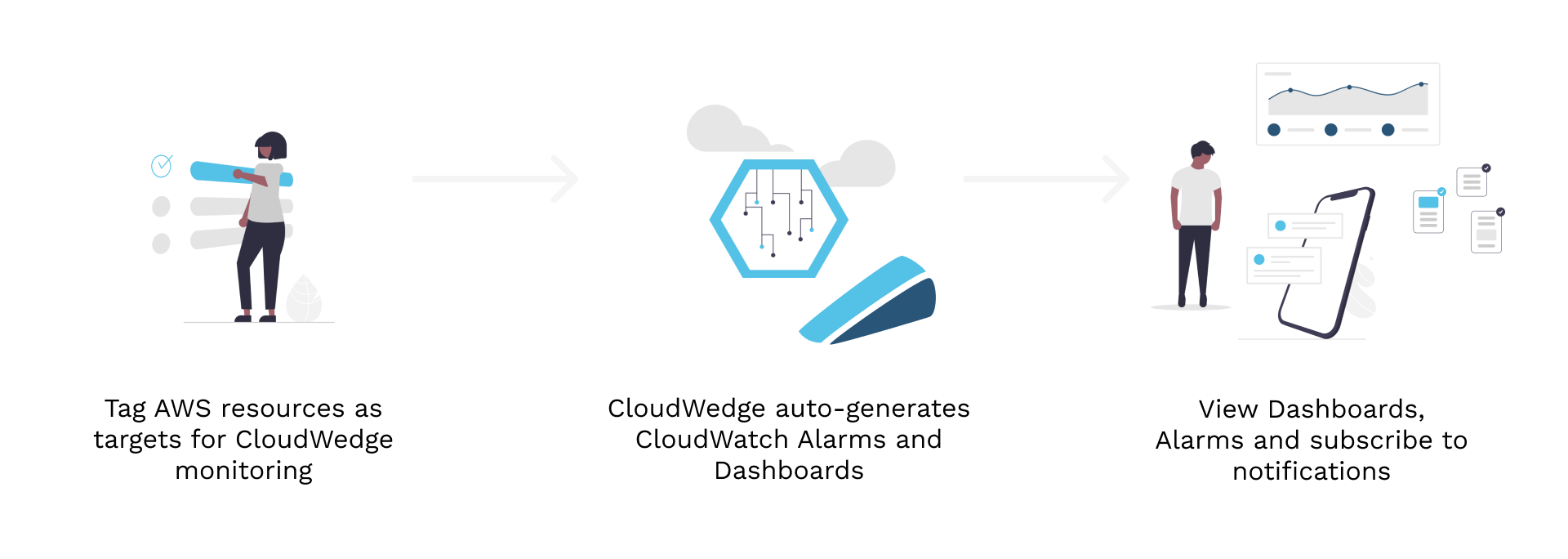#
Welcome to CloudWedge
CloudWedge is an AWS Cloudwatch monitoring framework that accelerates your ability to get up and running with native AWS monitoring services.

#
Features
CloudWedge is perfect for when you want to use the native AWS monitoring services, but you dont want to fuss with the all the implementation details. CloudWedge will provide the monitoring alarms and the dashboards you would have built by hand (or in CloudFormation) and give you back that time to focus on what really matters.
Essentially, CloudWedge is doing the "undifferentiated heavy lifting" of setting up CloudWatch and and wiring it into an alerting pipeline using SNS.
#
☁️ Native AWS
CloudWedge is using 100% AWS native services from the cradle to the grave.
#
🔐 100% Privacy
Your data never leaves your account. No 3rd party to ship data to, its all contained within the walls of your own home. Look at the source code yourself, we are not hiding anything. You have total control.
#
✅ Easy install
Installation takes only a minute. Them you only have to learn the custom CloudWedge "tags" and add them to your resources.
#
🙋 Opt-In Only
You choose what to monitoring and how. Decided the resources you want supported from the available AWS services.
#
💥 Event Driven
You change your environment, CloudWedge will update itself. Its not as sophisticated as true AI, but you might start to think so.
CloudWedge is not
- A competitor to more robust, but more expensive 💲💲💲, Application Performance Monitoring tools like DataDog, New Relic, Dynatrace, App Dynamcis etc..
- A fully customizable enterprise suite of monitoring tools with beautiful dashboard visualizations and stand-alone app support for all of your devices.
- An infinitely scalable monitoring tool.
CloudWedge is
- Better than nothing.
- A tool to automate away the complexity of setting up CloudWatch Alarms and Dashboards and facilitate alert notifications when those CloudWatch Alarms are breached.
- An inexpensive, easy to deploy, set of native AWS tools/services to get you up and running with monitoring and alerting on AWS.
- Easy to use — Just add tags!
- Extensible.
- Multi-account/Multi-region. (Coming soon)
#
How CloudWedge works
Getting a little more technical, here is a breakdown of the interactions between you, AWS and CloudWedge:
#
Example Usage
You can get started monitoring with CloudWedge by using the following CloudWedge core tags. Just slap a tag called cloudwedge:active on a supported service and watch the alarms get created. These are the core configuration tags:
#
Tag Name
cloudwedge:active
#
Tag Details
#
Tag Name
cloudwedge:owner
#
Tag Details
#
Tag Name
cloudwedge:level
#
Tag Details
#
Deployment
CloudWedge is packaged in a CloudFormation template. This makes is very easy to deploy. You just need to get a url reference to the pre-baked CloudFormation and then use the AWS CloudFormation console to deploy the stack into your account.
#
Getting Started
It's always nice to have someone show you around a new place. Check out the Getting Started guide to get comfortable using CloudWedge.
#
License
This project is licensed under the terms of the MIT license.
⚡ Let us know what you think!
Send us some a message in the chat bubble below or join the discussion on github.